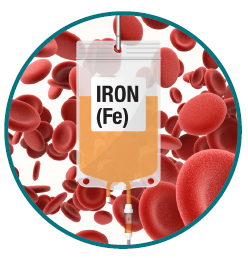Iron Infusion 
INTRAVENOUS (IV) IRON INFUSION
What is an IV iron infusion?
Intravenous or IV means giving something directly into the blood stream
of the body through your vein.
Why is iron important?
Iron is essential for the body to make haemoglobin (Hb) - red blood cells,
which is important for carrying oxygen from your lungs to the rest of your
body. Low haemoglobin levels (also known as anaemia) make you
feel tired. Very low levels may require you to have a blood transfusion.
Why are you being given an iron infusion?
The most common way to treat iron deficiency anaemia is to take iron by mouth as a tablet or liquid. Intravenous
iron infusion is an alternative way of giving iron.
IV iron infusion is given if you are:
- unable to tolerate iron taken by mouth
- unable to absorb iron through the gut
- in need of a rapid increase in iron levels to avoid complications or a blood transfusion.